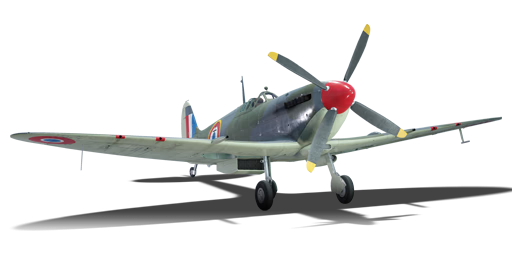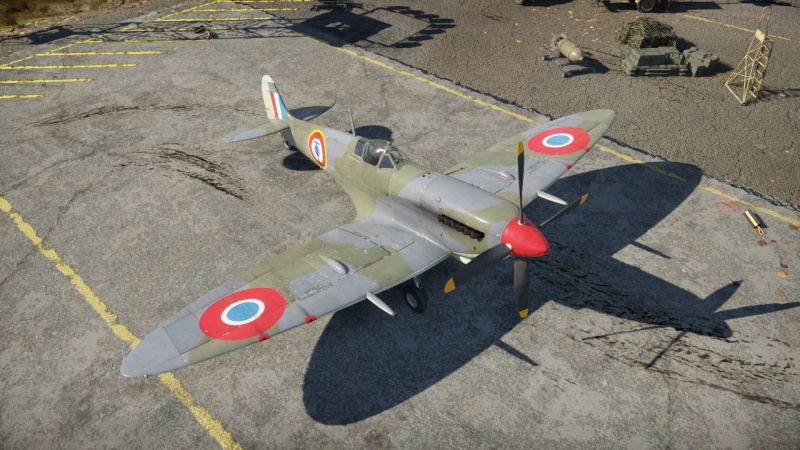Seafire LF Mk.III (France)
| This page is about the fighter Seafire LF Mk.III (France). For the British version, see Seafire LF Mk.III. For other versions, see Spitfire (Family). |
Contents
Description
The Seafire LF Mk.III was developed from the previous Seafire Mk.IIc which was a navalized version of a Spitfire Mk. Vc with modifications for carrier operations. France bought 141 Seafire LF Mk.IIIs after the war and they saw combat above Indochina, mostly providing close air support and raiding enemy camps from the sky with ground ordnance.
It was introduced in Update "Winged Lions". Compared to the regular version of the Spitfire, the Seafire has a mediocre climb rate, being slower at accelerating and also having a poor top speed. The engine is the main issue, since it also overheats regularly when using WEP. The 20 mm cannons are prone to jamming and overheating, and it is recommended to quickly research the modifications for the Mk.II 1943 cannons. However, being a Spitfire, the Seafire is still a very capable dogfighter, and it can outperform many aircraft like the P-51s and Bf 109s in similar conditions; however, avoid prolonged fights at all costs, since the Seafire has very poor energy retention.
General info
Flight performance
The Seafire has an abysmal climb rate, it is also quite slow for a plane at its BR. Side climbing is advised. The turn time is slightly worse than the Spitfire LF Mk IX but still good enough to outturn most of your foes. The engine overheats rather quickly when using WEP, so avoid prolonged use.
| Characteristics | Max Speed (km/h at 3,963 m) |
Max altitude (metres) |
Turn time (seconds) |
Rate of climb (metres/second) |
Take-off run (metres) | |||
|---|---|---|---|---|---|---|---|---|
| AB | RB | AB | RB | AB | RB | |||
| Stock | 561 | 541 | 10500 | 17.2 | 17.8 | 14.6 | 14.6 | 340 |
| Upgraded | 627 | 592 | 15.7 | 16.2 | 26.9 | 19.5 | ||
Details
| Features | ||||
|---|---|---|---|---|
| Combat flaps | Take-off flaps | Landing flaps | Air brakes | Arrestor gear |
| X | X | ✓ | X | ✓ |
| Limits | ||||||
|---|---|---|---|---|---|---|
| Wings (km/h) | Gear (km/h) | Flaps (km/h) | Max Static G | |||
| Combat | Take-off | Landing | + | - | ||
| 760 | 270 | N/A | N/A | 230 | ~10 | ~5 |
| Optimal velocities (km/h) | |||
|---|---|---|---|
| Ailerons | Rudder | Elevators | Radiator |
| < 321 | < 400 | < 350 | > 500 |
Survivability and armour
- Armour plates
- 7 mm steel plate behind the 4 mm steel pilot seat
- 6 mm steel headrest
- 38 mm front armoured glass
- 3 mm steel plate protecting liquid cooling system
- 3 mm steel boxes protecting magazines in wings
- Modules
- Vital components located at front of the aircraft (engine, fuel tank, pilot, radiator)
- One self-sealing fuel tank, one non self-sealing located above each other in front of the cockpit
Modifications and economy
The 20 mm cannon belts should be the first upgrade to be researched due to the very poor stock belt. After that, research the first cannon upgrade module to reduce spread and overheating. Unlock then flight performance upgrades: radiator first due to the rather fast overheating of the engine when using WEP. After that, it is up to the pilot to decide if they would rather profit from better weaponry or flight performance.
Armaments
Offensive armament
The Seafire LF Mk.III (France) is armed with:
- 2 x 20 mm Hispano Mk.II cannons, wing-mounted (120 rpg = 240 total)
- 4 x 7.7 mm Browning machine guns, wing-mounted (350 rpg = 1,400 total)
The wing-mounted machine guns are very hard to use at distances over 300 m due to their placement in wing. Cannons does not have such issue as they are closer to the wing roots.
Usage in battles
The Seafire LF Mk.III is a jack of all trades, but master of none. The Seafire does not climb well, so after start of battle, pilots should side climb, stay at around 3,000 m of altitude and let better climbing teammates tackle the first wave of enemy interceptors, trying to pick off those that managed to dive down. Still retaining great turning capabilities, the pilot is advised to force enemies into turnfighting where they bleed their energy and become vulnerable. Avoid head-ons at all cost due to the very fragile radiator and engine: even a single bullet will take it out.
- Enemies worth noting
- Bf 109
- Fw 190
- A6M series
- P-47 Thunderbolt
- Yak-3/9
- La-7
- Ki-84
All the enemies in the list above can outclimb you, and also outrun you with the exception of the A6Ms. However, all those foes (except the A6Ms) can be outturned by the Seafire in an horizontal engagement.
Manual Engine Control
| MEC elements | ||||||
|---|---|---|---|---|---|---|
| Mixer | Pitch | Radiator | Supercharger | Turbocharger | ||
| Oil | Water | Type | ||||
| Controllable | Controllable Not auto controlled |
Not controllable Not auto controlled |
Controllable Not auto controlled |
Separate | Not controllable 1 gear |
Not controllable |
Pros and cons
Pros:
- The engine doesn't overheat any faster than the engines of the other Spitfires
Cons:
- Poor mid and high altitude performance
- Slower than nearly all opponents
- Weak armament
- Outperformed by most other fighters at its tier
History
Describe the history of the creation and combat usage of the aircraft in more detail than in the introduction. If the historical reference turns out to be too long, take it to a separate article, taking a link to the article about the vehicle and adding a block "/History" (example: https://wiki.warthunder.com/(Vehicle-name)/History) and add a link to it here using the main template. Be sure to reference text and sources by using <ref></ref>, as well as adding them at the end of the article with <references />. This section may also include the vehicle's dev blog entry (if applicable) and the in-game encyclopedia description (under === In-game description ===, also if applicable).
Media
- Skins
See also
External links
Paste links to sources and external resources, such as:
- topic on the official game forum;
- other literature.
| Supermarine | |
|---|---|
| Spitfires | |
| Merlin engine | Spitfire Mk Ia · Spitfire Mk IIa · Spitfire Mk.IIa Venture I · Spitfire Mk IIb |
| Spitfire Mk Vb · Spitfire Mk Vb/trop · Spitfire Mk Vc · Spitfire Mk Vc/trop | |
| Spitfire F Mk IX · Spitfire F Mk IXc · Spitfire F Mk XVI | |
| Spitfire LF Mk IX · Plagis' Spitfire LF Mk IXc | |
| Griffon engine | Spitfire F Mk XIVc · Spitfire F Mk XIVe · Prendergast's Spitfire FR Mk XIVe · Spitfire F Mk XVIIIe · Spitfire F Mk 22 · Spitfire F Mk 24 |
| Export | ▄Spitfire Mk Vb/trop · ▃Spitfire LF Mk IXc · ▂Spitfire Mk IXc · Spitfire Mk IXc · Spitfire Mk.IX (CW) · Weizman's Spitfire LF Mk.IXe · ▄Spitfire FR Mk XIVe |
| Seafires | Seafire LF Mk.III · Seafire F Mk XVII · Seafire FR 47 |
| Export | ▄Seafire LF Mk.III |
| Jet fighters | Attacker FB 1 · Attacker FB.2 · Scimitar F Mk.1 · Swift F.1 · Swift F.7 |
| Hydroplanes | Walrus Mk.I |
| France fighters | |
|---|---|
| Dewoitine | D.371 · D.371 H.S.9 · D.373 · D.500 · D.501 · Pallier's D.510 · D.520 |
| Morane-Saulnier | M.S.405C1 · M.S.406C1 · M.S.410 |
| Arsenal | V.G.33C-1 |
| Bloch | M.B.152C1 · M.B.157 |
| Caudron | C.R.714 |
| Sud-Ouest | S.O.8000 Narval |
| American | H-75A-1 · H-75A-4 · ▄P-39Q-25 · ▄P-40F-5 Lafayette · ▄P-47D-22-RE · ▄P-63C-5 · F-6C-10-NA |
| ▄F6F-5 · ▄F6F-5N · F4U-7 · ▄F8F-1B | |
| Other countries | ▄Seafire LF Mk.III · ▄Yak-3 · Challe's ▄Yak-9T · NC.900 |
| Belgium | ▄Gladiator Mk I · ▄Spitfire FR Mk XIVe |
| Netherlands | ◘Sea Fury FB 51 |





